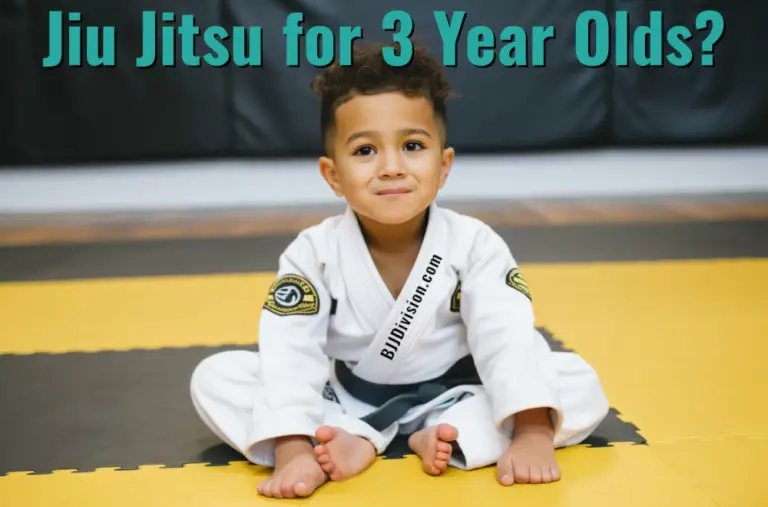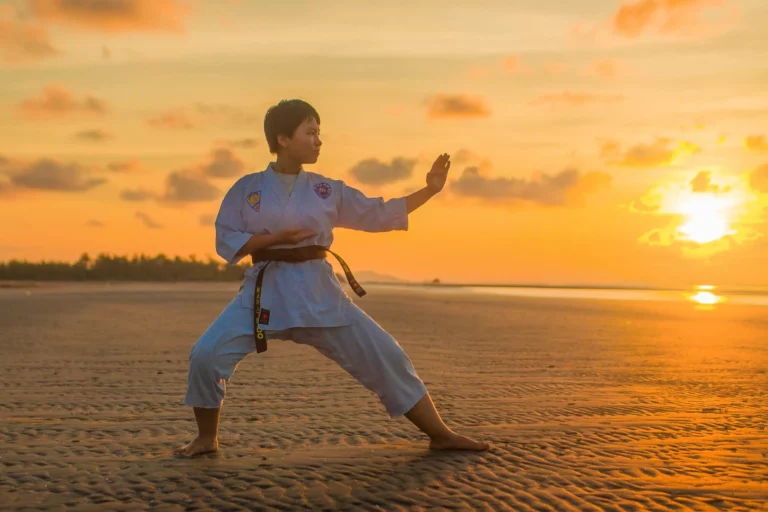Jiu Jitsu vs Muay Thai: Grappling and Striking Comparison
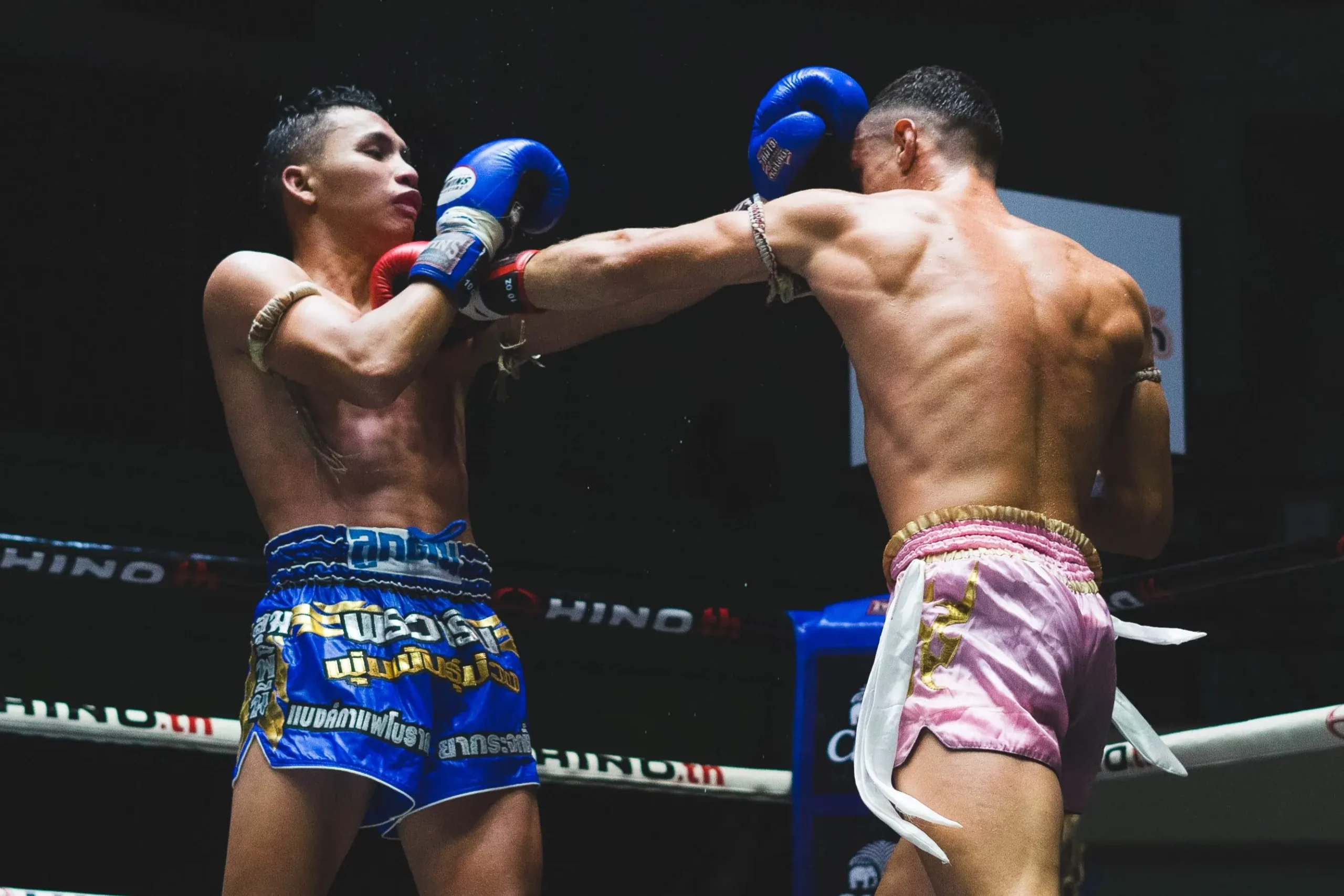
Jiu Jitsu vs Muay Thai: Although both are martial arts and combat sports, they are very different from each other. Muay Thai exclusively focuses on stand-up fighting while Jiu Jitsu mainly focuses on ground fighting.
In general, none of the two arts/sports is better than the other. Both martial arts have strengths and drawbacks and are often combined for the use in Mixed Martial Arts (MMA).
Below you can see our agenda for compared Jiu Jitsu and Muay Thai:
Differences and Similarities of BJJ and Muay Thai

Brazilian Jiu Jitsu originated from Judo but focused on ground fighting rather than throws from a standing position. It was mainly developed in Brazil by the Gracie brothers.
Muay Thai on the other hand developed in Thailand as a defensive and offensive art for soldiers. It later fulfilled several functions such as physical exercise, self-defense, offense, and personal advancement. In the last century it was formalized and brought to big stages.
Jiu Jitsu vs Muay Thai: Differences
Clothing
Jiu Jitsu was originally always trained wearing a Gi and later developed No-Gi Jiu Jitsu, where rashguards and shorts are worn. Muay Thai on the other hand is trained and fought only in shorts and sometimes traditional accessories like headbands and bracelets.
Positions
Jiu Jitsu fights start standing but the focus is on ground fighting where there is a complex system of positions.
Muay Thai mainly focuses on stand-up fighting since it is a striking art. The fighters take the sport specific fighting stance that is light on the front leg which enables the fighter to raise the knee fast so kicks can be thrown and incoming kicks can be blocked.
Styles & Philosophy of BJJ
In Jiu Jitsu there are mainly two “styles” that can be trained and fought: Gi and No-Gi Jiu Jitsu. Gi Jiu Jitsu puts a lot of emphasis on grips and related techniques. For example, the Lapel of the Gi is used to strangle the opponent. Grips provide more control and slow down the pace of a fight. On top of that, the Gi rulesets are more restricted than the No-Gi rulesets and certain techniques, like heel hooks, are not allowed.
No-Gi Jiu Jitsu is faster paced. Athletes fighting in No-Gi are more slippery and fighters usually progress through positions faster. The basics concepts are the same in both branches though.
Styles & Philosophy of Muay Thai
Let’s look a Kickboxing in general. There are mainly two Kickboxing styles: Thai and Dutch. In Thai Kickboxing, namely Muay Thai, elbows, kicks, knees, and clinch fighting are very common. On the other hand, Muay Thai fighters are often criticized for deficits in punching. Additionally, Muay Thai is very attritional and values fighting spirit and aggression in the judging criteria.
Dutch Style Kickboxing focuses on punching more. Its main influences are Western Boxing and Kyokushin Karate. Therefore, this style of kickboxing tends to be stereotyped to consist of flurries of punches that end in heavy low- or high kicks.
Check out how Joe Rogan and Will Harris rank the two different styles:
Training in BJJ
Classes in Jiu Jitsu usually follow a simple recipe:
- Warmup
- 1 hour of technique drilling
- Sparring
Training in Muay Thai
A typical Muay Thai class involves the following parts with variations in order and extend:
- Running (often in groups)
- Rope Skipping
- Shadow Boxing
- Pad Work and Sparring
- Heavy Bag Work
- Clinch Work
- Stretching
Rules in Brazilian Jiu Jitsu
At the risk of repeating ourselves, check out our section on BJJ Rules in our Jiu Jitsu vs Judo article.
Rules in Muay Thai
As Muay Thai is referred to as “The Art of Eight Limbs”, strikes using the elbows, knees, legs and hands are allowed. Strikes do not score if they only hit the opponent’s glove, forearm, foot, or shin. Additionally, blocked or guarded strikes don’t award any points.
The fight can be won through knockout, where one of the fighters is unable to continue fighting, or by points. If both fighters scored the same number of points, the fighter that landed the more powerful strikes wins.
Techniques in BJJ
BJJ tries to enable the smaller and weaker individual to defend themselves against the bigger opponent by using superior angles and using their momentum against them.
Techniques in Muay Thai
Muay Thai only teaches striking techniques and trips. Therefore, controlling the distance as well as using fast, powerful and well-timed attacks is essential to utilize Muay Thai successfully. The main Muay Thai techniques are:
- Punches: Jab, Cross, Hook, Uppercut…
- Elbows: Slash, Horizontal, Uppercut, Spinning…
- Kicks: Roundhouse, Straight, Diagonal…
- Knees: Straight, Diagonal, Flying…
- Foot-Thrusts
- Clinch and Neck Wrestling
- Defensive Moves: Blocking, Parrying, Avoiding…
Many Muay Thai striking techniques require a lot of conditioning to toughen up certain body parts, especially the shins. Muay Thai fighters are famously known for kicking against hard objects, like trees, as part of their conditioning routine:
Jiu Jitsu vs Muay Thai: Similarities
Positions
Muay Thai and Brazilian Jiu Jitsu fights start in a standing position.
Goal
Both were developed as means for self-defense and later developed to become a competitive sport.
Rules
Both sports have a point system under most rulesets.
Techniques
There are basically no similarities in techniques since Jiu Jitsu is a grappling art and Muay Thai is a striking art.
Culture
Both sports assume an appropriate amount of respect towards the opponent.
Both sports have traditional aspects to them. For example, bowing and sometimes lining up by rank after class is mandatory at most Jiu Jitsu schools and the Gi itself is traditional clothing. Muay Thai expresses tradition though traditional accessories like headbands and armbands as well as the traditional group training mentality.
Jiu Jitsu vs Muay Thai: Quick Comparison
A quick and concise comparison of the most important aspects of Jiu Jitsu and Muay Thai:
BJJ | Muay Thai | |
Self Defense | x | x |
Competition recognition | ||
Stand-up fighting | x | |
Ground fighting | x | |
Physical training | x | |
Mental training | x | x |
MMA and real-life usage | x | |
Popularity | x | |
Safety | x | |
Community | x | x |
Cheaper Price |
Jiu Jitsu vs Muay Thai: What would happen in a Real Fight or MMA fight?

To evaluate real fighting capabilities, let’s take a look at how each martial art performs in Mixed Martial Arts (MMA).
BJJ
There is undeniable proof that BJJ works in MMA and real fights. However, it also has its drawbacks.
Check out the in-depth section on Jiu-Jitsu in MMA in our Jiu-Jitsu vs Wrestling article.
Muay Thai
Muay Thai is one of the most effective striking martial arts for MMA. First, it is a full contact sport which is famous for its hard kicks and hard training regimens. The training intensity and conditioning of the whole body is very beneficial when preparing for an MMA fight.
Second, Muay Thai is a well-rounded striking art. Taekwondo might teach a fighter to throw kicks and boxing might teaches a fighter to throw punches, but Muay Thai teaches a fighter the whole spectrum of striking. It includes punches, heavy kicks, striking with elbows and knees, as well as clinch fighting and trips.
Third, Muay Thai style kicks are the bread and butter of many MMA fighters gameplan today. Especially the roundhouse kick to the legs is crucial in slowing down the opponent and forcing him to adapt his style to a compromised lead leg. Jose Aldo, who is by many consider the greatest MMA featherweight of all time, used these low kicks throughout his whole career.
Last, Muay Thai is extremely useful in clinch fighting and close fighting in general. The knee- and elbow attacks of Muay Thai are a devastating tool in these situations which arise frequently in MMA, especially when fighting close to the fence.
The downsides to Muay Thai are that it does not include any grappling or takedown related techniques and tends to be too stationary for MMA fighting. There is less focus on footwork and head movement than in other striking arts which sometimes makes a Muay Thai fighter an easy target.
Nevertheless, there’s a long list of successful MMA fighters that utilize Muay Thai techniques. Here are just a few:
- Jose Aldo: Long-time UFC Featherweight Champion that uses brutal Muay Thai leg kicks.
- Anderson Silva: 10 title defenses in the UFC and one of the most fluid and effortless strikers the UFC has ever seen.
- Joanna Jedrzejczyk: Former UFC Strawweight Champion that started training Muay Thai at the age of 16.
- Shogun Rua: Former UFC Light Heavyweight Champion that was a member of Chute Box Academy, a Muay Thai academy.
- Edson Barboza: One of the most exciting strikers the UFC has ever seen. He is known for his spectacular head kick knockouts.
And the list goes on… Muay Thai can definitely be successful MMA, if incorporated correctly.
Summary
Both arts have their place, and both can be effective in real fights. They focus on very different aspects of fighting. Therefore, their effectiveness depends on the exact fighting situation. As a result, the combination of Jiu Jitsu and Muay Thai is certainly one of the best an MMA fighter can practice.
Jiu Jitsu vs Muay Thai: Self Defense

Which martial art is better for self-defense. Jiu jitsu is a control-focused martial art, while Muay Thai uses strikes with different body parts and from different distances.
When it comes to one-on-one self-defense situations, Jiu Jitsu is the winner. Karate might win in more dynamic fight situations, and here’s why.
First of all, Jiu Jitsu doesn’t involve any striking techniques or striking defense. Muay Thai on the other hand involves striking techniques that are effective from any distance since Muay Thai also works the clinch.
BJJ
The overwhelming success BJJ has had in MMA fights throughout the recent years is a testament to how well rounded it is.
At the risk of repeating ourselves, check out our article on Jiu Jitsu vs Wrestling, which includes an in-depth section on how BJJ performs in a real fight.
Muay Thai
Muay Thai is a well-rounded striking art as it uses all parts of the extremities to strike an opponent, hence the name “The Art of Eight Limbs”. This enables a Muay Thai fighter to use effective striking from all distances.
On top of that, Muay Thai attacks, especially the Roundhouse Kick, are known for their devastating power. This power, which his generated by using the momentum of the whole body, allows a Muay Thai fighter to end conflicts early.
Statistically seen, most fights start standing but go to the ground fairly quick in a one-on-one confrontation. In this case a Muay Thai fighter wouldn’t be able to utilize many of his techniques. He would have to avoid the opponent getting a controlling grip of him at all costs or engage his own attacks from a close position as soon as possible. Therefore, Muay Thai is ineffective in certain self-defense situations.
In a dynamic fighting scenario on the other hand, where several aggressors might become involved in the fight, Muay Thai techniques might be the better choice. These techniques allow to knock out or disable an opponent from a distance while preserving the ability to disengage at all times. This makes Muay Thai superior to BJJ in many real-life fighting situations involving several aggressors.
Here’s what Jocko Willink thinks is the best martial art for self-defense:
Ranking Systems in BJJ and Muay Thai

BJJ
The image below shows the IBJJF’s (International Brazilian Jiu-Jitsu Federation) Graduation System, which includes all of Jiu Jitsu’s belt ranks: white, blue, purple, brown, and black, as well as the Coral Belt and Red Belt.
The overview shows the belt progression, promotion times, and minimum ages for each belt.

Muay Thai
Traditionally Muay Thai schools do not have a ranking system that involves belts of different colors. Fighters have to prove themselves in competition.
Modern Muay Thai schools, especially in the west, are sometimes using an armband ranking system. These traditional armbands are called praciat, prajiet, or prajead and have originally not been part of a ranking system.
This modern ranking system is not an essential part of the sport yet and is looked down at by many practitioners today. The hardcore mentality, which made Muay Thai what it is today, demands a fighter to prove himself in battle.
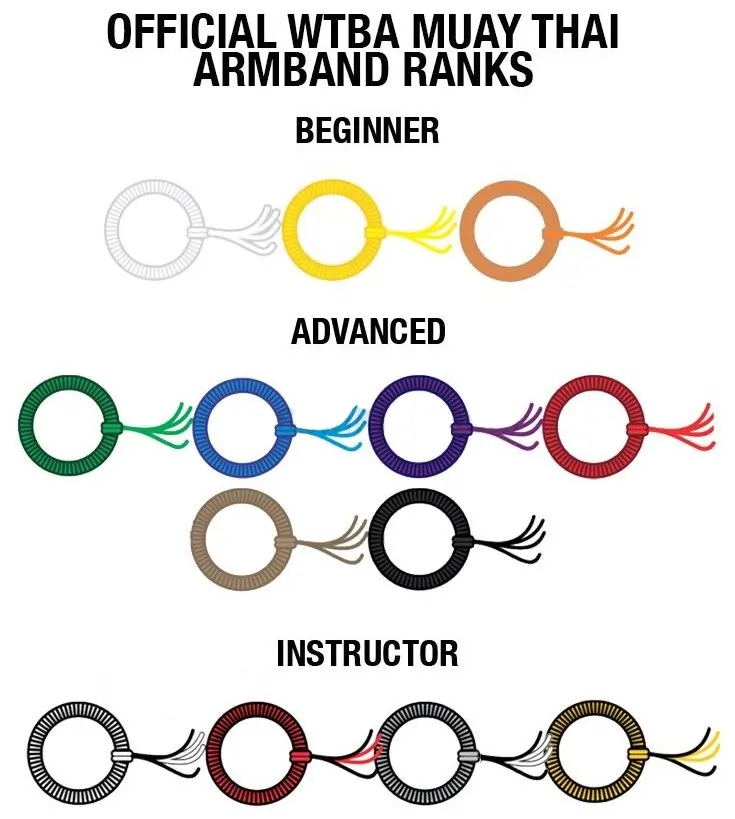
Competition

BJJ
Rulesets for BJJ competitions vary for different promotions and federations.
We wrote an in-depth article on Jiu Jitsu’s Olympic status and the biggest competitions in BJJ.
Muay Thai
In July 2022 the International Olympic Committee (IOC) certified Muay Thai as an Olympic sport and granted the International Federation of Muay Thai Associations (IFMA) permanent membership of the Olympic Committee. Muay Thai is in the works to be part of the Olympic Games in 2024 in Paris.
For now, a “standard ruleset”, under which fights at the Olympic Games can take place, has to be declared. If the formalities can’t be solved in time Muay Thai might have to wait until 2028 to debut in the USA.
The biggest titles in Muay Thai for now can be won at different stadiums in Thailand. Some of the most prestigious belts are:
- Lumpinee Belt: This belt can be won at the Lumpinee Stadium in Bangkok which is run by the Royal Thai Army.
- Rajadamnern Belt: This belt can be won at the Rajadamnern Stadium in Bangkok which was the world’s first Muay Thai stadium.
- Thailand Belt: Can be won at the stadium in Montri Ladprao Road in Bangkok.
- WPMF Belt: This belt is given out by the World Professional Muaythai Federation which was formed in 2004.
- WBC Muay Thai Belt
- Channel 7 Belt
- Thai Fight Belt
History & Culture

Jiu Jitsu started as a self-defense martial art. Today it is used for offense, defense, and professional fighting.
Evidence for the existence of Muay Thai dates to at least the 16th century. At that time, it was practices by soldiers under king Naresuan. In the 19th century the sport made tremendous progress under King Chulalongkorn’s (Rama V) reign since the king had great interest in the sport. In the early 20th century Muay Thai was formalized and the first big Muay Thai stadiums were built. This is when the term “Muay Thai” became commonly used. Today Muay Thai is a prestigious sport that honors toughness and hard work.
Popularity

Muay Thai used to be more popular than Jiu Jitsu not too long ago, but Jiu Jitsu steadily caught up in popularity over the last years and has overtaken Muay Thai in popularity recently.
This can be seen through Google Trends, as shown in the image below. Jiu Jitsu is constantly growing in popularity worldwide, while Muay Thai’s popularity declined in the last decade.

In Brazil, the home of Brazilian Jiu Jitsu, BJJ is more popular than Muay Thai today. The same goes for many South American countries. In Asia, Europe, and Australia, Muay Thai is more popular today. Both sports are very popular in North America today.
In the USA, both are equally popular with Muay Thai having a slight edge (therefore colored light red). Lastly, the popularity trends in the USA mostly reflect the popularities worldwide, where both sports very close in popularity today.
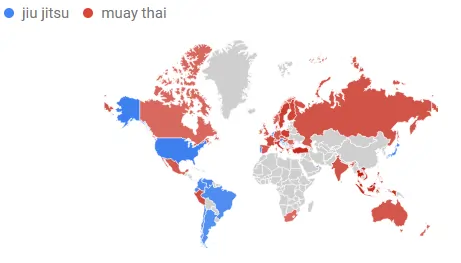
Jiu Jitsu is getting more and more popular as their many celebrities and public figures that train BJJ and spread the word for the sport. Check out our full list of BJJ celebrities in our in-depth article.
Injuries in BJJ and Muay Thai

As both sports are full-contact combat sports but differ in the type of techniques used, we can assess which style of fighting is more dangerous.
First, there is an inherent risk of injury when taking part in any of the two sports, which cannot be completely eliminated. Almost everyone that trains one of the two sport for long enough has been injured.
BJJ
At the risk of repeating ourselves, we refer to our extensive article on How common are Injuries in BJJ? in which we conducted our own study based on Reddit data. On top of that, we analyzed most academic studies on BJJ injuries available.
Muay Thai
When it comes to Muay Thai there are several studies showing similar injury rates. A study from 2016 found an injury incidence rate of 55.4% for competitive Muay Thai fights. Most of the reported injuries were soft tissue injuries of minor severity.
Nevertheless, 18.5% of all reported injuries were considered severe, meaning they either effected performance or interfered with the completion of the fight or subsequent training sessions. As a result, the injury incidence rate of for severe injuries is about 10% for competitive Muay Thai fights.
With a percentage of 51% of all injuries, the lower extremities were most effected. This is to be expected for a sport that focuses on throwing hard kicks with a lot of momentum. Therefore, the lower extremities can take damage when involved in offensive or defensive maneuvers. 20% of all reported injuries involved a fracture or concussion.
Summary
The overall injury rate in competitive Muay Thai fights compared to Jiu Jitsu fights is significantly higher. This was expected since striking sports are based on rapid movement and involve more force generated through momentum.
Cauliflower Ear in BJJ and Muay Thai
Cauliflower ear is common in Brazilian Jiu Jitsu as well as Judo. Check our Jiu Jitsu vs Wrestling article where we talked about causes treatment and prevention of cauliflower ear.
Conclusion: BJJ vs Muay Thai
None of the two sports is better than the other. Practitioners of each of the sports should be open to learn from each other and incorporate aspects of both arts into their fighting arsenal.
The two arts focus on different aspects of fighting. Therefore, Jiu Jitsu and Muay Thai provide a good foundation for MMA fighting and self-defense. Many top-level MMA competitors incorporate Muay Thai and Jiu Jitsu into there fighting game and have achieved high expertise in both sports.
If you are curious how Jiu Jitsu compares to other martial arts, check out or articles on:

